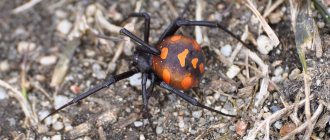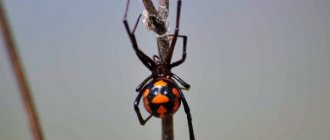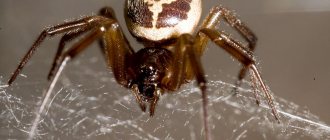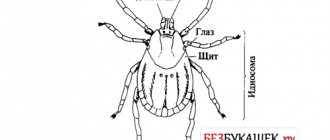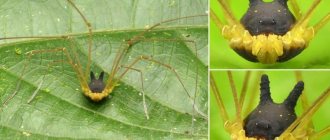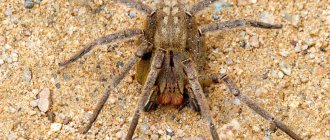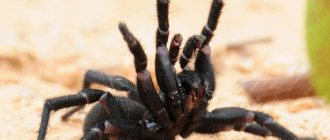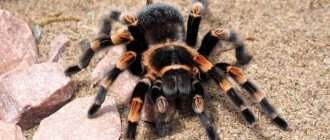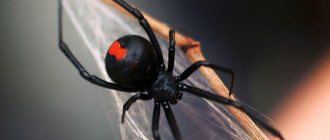Welcome to the world of the most dangerous spiders. The ancestors of spiders (Araneae) lived on our planet more than several hundred million years ago. By the way, modern spiders in their genetic portrait are related to crabs. And today, just imagine, almost four tens of thousands of species are known. By the way, for those who don’t know, spiders are not insects. They form a separate order, and accordingly a separate class of animals.
These creatures live everywhere, even in water. As a rule, they have eight legs, a pair or even several eyes, and the forelimbs are called chelicerae. At their tips are miniature claws, which the predator plunges into the body of its prey, after which it injects saliva into it through the mandibles, which has the property of turning the tissues of living creatures into jelly. After such gastronomic preparations, the spider simply drinks the victim.
Fortunately, spiders prefer insects and small animals. Representatives of the entire class are poisonous, but people should only beware of meeting certain species. They will be discussed in this article.
List of the most dangerous spiders in the world:
1
Brazilian spider soldier / Phoneutria
Aggressive, fast and poisonous creatures. Known as armed or banana spiders. By the way, the name is associated with the animal’s ability to do without a web. These spiders just don't weave it. Moreover, they are nomads and do not stay anywhere for long. This travel spider can be found not only in tropical forests, but also in huts and other dwellings.
Favorite hiding places in the house are dishes, clothes and shoes. So, if you are planning to visit Brazil, be sure to make sure that there is no such “guest” in your shoes or bed. After all, its bite is very dangerous for humans. A bite can kill a person with a weakened immune system within 10 minutes. If an antidote is not administered within 20–30 minutes, even an adult and healthy man can die from the bite.
By the way, on our website topcafe.su there is a fascinating article about the most poisonous insects on the planet.
2
Horrible in person
But almost cute on the inside. All tarantulas are poisonous, but their venom is low-toxic and the bite of these spiders is not dangerous to humans. Unless the victim has an allergic reaction to spider venom. But in this case, the size of the spider is not so important.
If you arrange spiders in descending order, you will get something like this rating:
- Theraphosa blondi (Goliath species).
- Heteropoda maxima (species of Heteropoda maxima).
- Acanthoscurria (genus of spiders Acanthoscurria).
- Nhandu coloratovillosus (Coloratovillosus species).
- Nhandu tripepii (Nandu tripepii species).
- Brachypelma smithi (Species of Brachypelma smithi).
- Lampropelma nigerrimum (Lampropelma nigerrimum species).
- Lampropelma nigerrimum arboricola (species Lampropelma nigerrimum arboricola).
- Aphonopelma seemanni (species of Aphonopelma zemanni).
- Avicularia purpurea (Species of Avicularia purpura).
On a note!
The size of a spider is usually determined by the span of its legs, since the body can be quite tiny. From this point of view, Heteropoda maxima should be in first place, since it surpasses Goliath in the length of its legs. But Goliath looks more impressive.
Goliath
The female's body grows up to 10 cm. Males are smaller - 8.5 cm. The paw span can be 28 cm. The color is dark brown. The body is completely covered with short reddish-brown bristles. Lives in the tropical zone of South America.
The most terrible spiders
On a note!
Although a goliath's bite is not dangerous, its venom can cause skin irritation. More serious damage is caused by the bristles, which are the spider’s main defense. Easily separated from the tarantula's body, the bristles cause an allergic skin reaction in humans.
Heteropoda maxima
It rivals Goliath in size, although the female’s body length is only 4.6 cm, the male’s is 3 cm. But the limb span is 25-30 cm. The species was recently discovered in Laos. The color of spiders is brownish-yellow. There are no gender differences in color. Presumably the species lives in caves. The toxicity level of the venom and the strength of the bite are unknown. But this tarantula looks really creepy. Especially because of the large chelicerae.
Acantoscuria
This is a genus of large spiders. The paw span of the smallest species is 12 cm. The largest is 22 cm. The color is dark brown with a light border along the cephalothorax and light stripes on the paws. Outwardly it resembles the South Russian tarantula, but has a more attractive appearance.
Nervous character. If disturbed, it may bite. Considering the easily excitable nervous system of arthropods and their number in tarantula lovers, the venom of representatives of this genus is low-toxic.
Rhea coloratovillosus
The body and paws of the animal are covered with thick and long reddish bristles. The length of the female is up to 9 cm. The paw span is up to 18 cm. A native of Brazil. Stubble that easily falls out poses a danger to humans.
Rhea thriperia
A very fluffy arthropod whose pink or red bristles perform a protective function. Therefore, the spider itself does not exchange bites and is valued for its docile disposition. The paw span is up to 18 cm. Females grow up to 8 cm, males up to 5 cm. Country of origin is Brazil.
The most terrible spiders
Brachypelma smithy
The body dimensions are close to Goliath: up to 9 cm. The paw span is up to 17 cm. The tarantula has a very beautiful coloring: a dark background with red spots on the paws. With age, the contrast intensifies.
It uses bristles as protection, since the poison is slightly toxic. The bite is not dangerous to humans. In addition, the animal has a very calm disposition.
Lampropelma nigerrium
The body size of adult individuals is 6-8 cm. The paw span is 17-19 cm. In particularly large specimens, the leg span can be 20 cm. The color of females is jet black, males are ashen, with a striped pattern on the abdomen.
On a note!
The character is vile: fast, aggressive and unpredictable, without hesitation he bites. The poison is dangerous for humans.
Lampropelma nigerrium arboricola
Body size up to 8 cm, paw span up to 18 cm. Females are black, males are ash-yellow. Animals are burrowers. They hunt at night.
The character is similar to its brother in its genus: an aggressive, fast arthropod with strong poison. In the absence of shelter, it is prone to bites. The poison can cause several unpleasant days for a person.
Afonopelma zemanni
The paw span is up to 14 cm. The color is black or dark brown with light stripes on the paws. They are nocturnal. Fast and active only at night. The rest of the time they prefer to sit in shelters, as they do not like sunlight.
The poison is weak. The bite is similar in strength to that of a wasp. When a person is bitten, local irritation and swelling go away on their own after 2-3 days.
The most terrible spiders
Avicularia purpura
An inhabitant of Ecuador in nature builds nests in hollows. Likes to use voids in human habitation for nesting. Completely covered with thick black bristles that glow purple-blue in the sun. Grows up to 6 cm. Leg span up to 14 cm.
Protection is provided by irritating bristles, since the venom is weak and the bite is not dangerous to humans.
Although photos of scary tarantula spiders make an impression, it is not these giants that are truly dangerous, but modest little spiders. Often these spiders have an inconspicuous camouflage color.
funnel web spider
Funnel web spiders are distributed throughout the world, there are more than 500 species. For the most part, the bites of these spiders do not have serious consequences for humans, but some species can pose a serious danger.
In the photo: Sydney leukoweb spider / Atrax robustus.
So, for example, the bite of a Sydney leucoweb spider can instantly kill a child, while an adult will suffer for no more than 15 minutes... Death occurs due to intoxication of the body and irreversible damage to the central nervous system. Primates can also suffer from a bite, while other mammals may not worry - the venom of the funnel-web spider does not have lethal properties for them and can only cause a slight illness.
Where do poisonous spiders live?
Poisonous arachnids live throughout the world. They usually choose insects and animals as their victims, and bite people only if they feel they are in danger.
Poisonous spiders live on almost all continents of the world. Most often, deadly representatives of the arachnid class can be found in Australia, and in most of Russia such individuals live only in small numbers.
Black Widow
In the photo: a female black widow guards a egg cocoon.
The bite of Latrodectus mactans poses a serious danger to humans. These creatures are also unkind to their relatives. So, for example, females eat males after mating, hence the name - widow. Moreover, the poison is more toxic in females.
This type of spider also belongs to the genus of the same name, which has 31 species. Not all types of black widows are dangerous.
They often crawl into people's houses in search of a more comfortable place for a brood of spiderlings. The female guarding the egg cocoon is very aggressive. She can easily bite anyone who invades her territory. Once in the human body, the poison provokes convulsive muscle contractions. And before the invention of the antidote, about 5% of people bitten by a black widow died.
Yes, and the male sometimes manages to escape from the female after mating!
5
Cyclocosmia
A spider with a “seal” on the back of its body makes a very unpleasant impression. Especially his thick short legs and his belly, as if cut off at the end. The size of Cyclocosmia usually does not exceed 7-8 cm, taking into account the paw span. The fleshy, plump abdomen ends in a chitinous disc, which is covered with sharp spines. If the spider is in danger, it crawls into the hole, putting its “shield” out. These strange creatures live in the southern states of the USA and some Asian countries and have an aggressive character. They are not dangerous to humans, but they can bite very painfully.
Karakurt
It can easily be confused with a black widow due to its external resemblance. But Latrodectus tredecimguttatus is still larger in size. They prefer to avoid living near human habitations and are distinguished by their peaceful disposition. They attack only when they are disturbed. And this is not an attack, but self-defense. Large horned animals often become victims of this species. Latrodectus tredecimguttatus has been known to bite people. There have even been cases of fatal bites.
The bite of the karakurt is very painful. The victim feels a sharp pain and burning sensation. And after 10–15 minutes, when the poison spreads throughout the body, people begin to experience pain in the lower back, abdominal area or chest. All this is often accompanied by headaches, shortness of breath and vomiting.
I wonder how the person in the photo is not afraid to hold this dangerous karakurt? Maybe he's holding a dead spider?
6
Heiracanthium
This is the most poisonous spider in Europe, often found in its northern regions. However, it, like karakurt, can also be found in Russia (there are known cases of bites in Bashkortostan, Tatarstan, as well as in the Chelyabinsk region). This is a pale, yellow or beige, small spider, usually no more than 1 cm in length. Another name for Heiracanthium is the yellow-sac piercing spider. The poison is not fatal, but has a strong effect on the human nervous system. The first symptom is severe burning pain. After some time, general weakness and body aches, headache, nausea and vomiting, and fever are observed. This may last for several days.
Brown recluse spider
This not very attractive creature lives in the east of America. The bite of Loxosceles reclusa is dangerous for humans, since the venom contains substances that can cause necrosis of the subcutaneous tissue. Moreover, these spiders, it turns out, love to live next to people. They can be found behind paintings, baseboards, and in shoe boxes. In the wild, you can meet them under tree bark, in crevices or in burrows. Naturally, this meeting cannot be called friendly.
The bite of recluses is not fatal, although rare cases of death have occurred. Victims describe the moment of the bite as a faint feeling of a needle prick. Some people don't even notice the moment of the bite. But after some time, the poison begins to act, causing tissue necrosis near the bite site.
7
Beware of necrosis
Residents of northern Mexico, the southwest and southeast of the United States are neighbors with the brown recluse spider. The specific dark pattern on its back determines its second name, violin. It reaches 2 cm in length (including legs). In addition to the color that gave it its name, it can be yellow-brown or gray.
Spiders are mainly nocturnal. Males easily escape from the twisted web, females do this reluctantly. During the day they hide in secluded corners. In search of a dry, dark place, they crawl into woodpiles or houses: into closets, shoes, under baseboards. Sometimes they are found in bed. It is through carelessness that most bites occur, which feel like a needle prick.
Spider venom causes tissue necrosis (the diameter of the wound can reach 25 cm), nausea, fever, and weakness. Yellow Sak spiders also have a similar effect on the human body. They are distributed throughout the Old World. They are painted in golden tones, individuals of both sexes grow no more than 5-10 mm. Some spiders like the smell of gasoline and prefer to live in cars. Their nests have a specific cylindrical shape.
Tarantula
Belongs to the family of wolf spiders. The tarantula can be found anywhere it is warm and humid. Lycosa live for more than 30 years and are considered true centenarians. They feed on small mice, toads, and insects. The bites are very painful, but not fatal. Often in people bitten by tarantulas, the area near the bite site becomes yellow for several months.
Currently, more than 200 species of tarantulas are known. If you want, TopCafe will write an article about the most beautiful tarantulas. Write in the comments if you want to admire it.
8
Yellow sac spider
Cheiracanthium punctorium lives in Europe, but it is not so easy to meet it, since it has a timid disposition and prefers to avoid random meetings with people. If he realizes that he has been discovered, he hides in the leaves. The venom of the yellow-sac spider is very dangerous and gradually affects the body. At first, the person experiences nausea and headache, then the condition worsens. Spiders do not attack people, but the latter can become victims through negligence. The bite is very painful, comparable to a stinging wasp. After a bite, even with the introduction of an antidote, long-term non-healing ulcers and wounds may remain on the skin.
9
Sandy six-eyed
Representatives of these arthropods continue to make the top 10 most dangerous spiders in the world. These are small individuals, reaching a length of 8-15 mm. Outwardly, such spiders resemble crabs. This resemblance is given to them by the relatively large legs bent at the knees, the length of which reaches 50 mm. The slightly flattened shape of the arthropod’s body also resembles a crab. This most dangerous spider (photo below) received its name because of its inherent shade of brown color and the presence of six eyes.
The habitats of the sand six-eyed are the territories of South Africa and the lands of South America. Depending on the area where they live, these spiders have different concentrations of the deadly substance in their saliva. Thus, African individuals are endowed with more lightning-fast and deadly poison than their American relatives. Perhaps the reason for this lies in the climatic characteristics of the Namib Desert.
The six-eyed sand spider hunts for small insects. Larger scorpions also become its victims. The spider waits for its prey, buried in the sand. The hairs located on the body help it in camouflage. Grains of sand stick to them, making the hunter a successful conspirator.
The venom of this spider affects the body of its victim in an unusual and unique way. A toxin still unknown to science negatively affects blood vessels, destroying their walls. This process occurs due to slow necrosis. The victim's blood also has a detrimental effect. It begins the active destruction of red blood cells. Thus, the venom of this arthropod is a very effective killing weapon. Fortunately, encounters between the six-eyed sand spider and humans are very rare. Only two cases of death resulting from an attack by this arthropod have been recorded.
White tail spider
Until recently, spiders were considered one of the most dangerous spiders; their bites left ulcers and wounds on the skin. But more recently it was discovered that white-tailed spiders... are not poisonous. True, some scientists still question the results of recent research. And there have not yet been any brave souls ready to test the toxicity of the bite.
In the photo: Australian Lee Porter
There is widespread material on the Internet about how the bite of a white-tailed spider greatly ruined the life of one Australian. After the bite, the young man developed a non-healing wound, which later developed into a tumor. As a result, doctors had to remove the tumor, which had spread to the Australian's eye.
10
Features of character and lifestyle
Photo: Camel spider in Crimea
Bihors are very active. They hunt mainly at night, although diurnal species are also found. During the winter, arthropods hibernate, and some species can do so during the summer months. They received the name “Wind Scorpion” for their ability to move at a speed of 16 kilometers per hour. Large individuals jump at a distance of more than one meter.
These creatures are aggressive, but not at all poisonous, although their bites can have serious consequences. Large individuals are capable of biting through human skin or nails. If rotting remains of their victims are present on the mandibles, they can enter the wound and cause blood poisoning or, at a minimum, inflammation.
The creature is absolutely not afraid of people. At night, phalanxes can easily run into the tent by the light of a lantern, so the entrance should always be closed. And when climbing inside, it’s better to check once again whether the animal has run in with you. Personal belongings also need to be kept in the tent, since a salpuga tired after a night hunt can climb into them to rest.
It is impossible to kick a bihork out of the tent. She is very nimble and persistent, so all that remains is to kill her or sweep her with a broom. It is advisable to do all this with thick gloves, and it is better to tuck your trousers into your boots. It should be remembered that it is impossible to crush an animal on the sand.
Best articles : Pungsan: the mysterious dog from North Korea
Mouse spider
Spiders were given such a strange name because of the mistaken belief that, like mice, they dig holes for themselves. The myth has dissipated, but the name remains. True, spiders are still related to mice. They feed on them, like other types of spiders. But nature tries to balance everything. Therefore, she turned mouse spiders into prey for wasps, scorpions and centipedes. The venom of these creatures is also toxic to humans, but, fortunately, these spiders do not like to live near human habitation.
Today, eleven species of these spiders are known, and all of them are endemic to the Australian continent.
11
Hairy spider
A collective name that rather characterizes the spring feature of spiders than a specific species. However, a large hairy spider, regardless of its species, is already a cause for concern. A hairy spider already sounds disgusting!
If its venom is also toxic to humans, then it would be best to beware of encountering a large hairy spider. However, today more and more spiders are kept as pets. By creating comfortable living conditions for them, owners can observe the life of predators live.
As a rule, beautiful and spectacular photographs of hairy spiders depict tarantulas, tarantulas or jumping spiders.
12
Spider baboon
One of the most poisonous and large spiders. Fortunately, it is not found in Russia, but lives in Tanzania, Uganda and Kenya. Spiders live in deep, up to 2 meters deep, burrows; the hind legs are much larger than the front ones. At the entrance to the hole, the spider spreads a web, which catches insects and small animals (even snakes). Hearing the vibration of the web when the victim is in it, the spider crawls out of the hole and starts eating. All that remains of the victim is its paws, because the predator is merciless.
13
Secretive six-eyed
The central regions of South America and the deserts of Africa are home to a small (body up to 1.5 cm, legs about 5 cm) killer six-eyed sand spider. Outwardly, it resembles a crab, the color is yellow or brown in different shades, allowing it to blend in with the surrounding soil. That is why it is also called sand spider or crab spider. Its characteristic feature is the presence of three pairs of eyes instead of the traditional four. It can live up to 15 years; in other species this value does not exceed 3.
Six-eyed spiders almost never weave webs. Exceptions are the cocoon sacs in which the female lays her eggs. These spiders hunt by waiting for prey in ambush. They are generally secretive and prefer to avoid people. Therefore, although they are very poisonous, only 2 of their victims have been recorded. The deadly substance injected by the spider destroys the blood vessels, and the person slowly dies from internal bleeding. Unfortunately, there is no antidote yet.
Red-backed Australian Widow
Australia is home to many different poisonous and very dangerous animals. And spiders are no exception. The creatures' long and strong fangs are so powerful that they can bite not only human skin, but also a human nail. Spiders attack instantly, having previously performed a ritual dance and demonstrated their fangs. The victim is paralyzed not only by the poison, but also by fear of the dancing killer.
It is considered the most dangerous and poisonous resident of Australia. Its venom is filled with neurotoxins. When bitten, a person feels severe pain, from which even an antidote, which can only be purchased at your own expense, will not help. TopCafe does not want anyone to experience this for themselves.
14
Camel spider, also known as the wind scorpion and salpuga
The spider grows up to 7 cm, and taking into account the straightened legs - up to 15 cm. Pale yellow color, chelicerae similar to a toothed bird beak or crab claws, hairy legs and a thick belly - all this makes the camel spider scary and unpleasant to look at. The picture is completed by the nasty squeak that he makes when attacked. It is better to avoid this inhabitant of the steppes and deserts. Although it is not poisonous, it can cause a painful bite even through a human fingernail.
Goliath tarantula
Are you afraid of spiders? After meeting this species, you will become even more afraid of them. Theraphosa blondi is also known as the tarantula spider or goliath tarantula. What does this monster look like? Adults can reach sizes of up to 25 centimeters, with legs measuring 15 centimeters long and body length 10 centimeters.
15
Brown Widow / Latrodectus geometricus
Brown widows are thought to have originated in Africa, but the first described specimen lived in South America. Representatives of this species settled in many parts of the planet. Populations of brown widows are found in southern California, the Caribbean, many US Gulf Coast states, as well as Japan, South Africa and Madagascar, Australia and Cyprus.
They can be found in residential buildings, garages, inside old tires and under cars, as well as among bushes and other vegetation.
The brown widow's venom is twice as strong as the black widow's. However, this species is not aggressive. Even when they bite, spiders do not inject all the venom they have. However, there were two reported cases of death from brown widow bites in Madagascar in the early 1990s.
16
List of the most poisonous spiders in the world
Four pairs of eyes, eight legs and a terrifying appearance make these creatures incredibly disgusting. But some spiders become even scarier when you consider that they are poisonous. Let's consider the most dangerous individuals, whose bite can harm health and even life.
Redback spider
This spider, like many other deadly poisonous creatures, lives in Australia. Its peculiarity is the presence of powerful front fangs, thanks to which it can bite not only the skin, but also a human nail. Before attacking the victim, the predator performs a ritual dance, which is even more terrifying and literally paralyzes with fear.
The red-backed spider is a dangerous representative of the fauna that lives in Australia
This creature is considered the most poisonous and dangerous in Australia; its bite is accompanied by severe pain. To neutralize neurotoxins that have entered the body, it is necessary to purchase an expensive antidote.
Tarantula
Tarantulas prefer warm and humid climates. There are about 200 species of them in the world. These spiders are considered long-lived, as they live for more than 30 years. Their diet consists of insects, toads, and small mice. A tarantula can bite a person only if it sees him as dangerous. The bite site will remain yellow for several months, but serious consequences after an encounter with a tarantula are unlikely to be expected.
Tarantula is a large poisonous spider that bites humans only in case of danger.
Heiracanthium
This is a poisonous monster that prefers to hunt in the dark. He lives in Europe, Australia, South Africa and eastern Asia. You can meet Cheiracanthium in bushes and among stones - here it waits for its prey. As soon as the insect touches its paw, the predator will instantly attack it and destroy it. This type of arthropod feeds mainly on caterpillars, aphids, mites, moths, etc. But recently, rumors have increasingly appeared that Cheiracanthium bites humans. A wound on the skin takes a long time to heal, and poor health can bother you for several hours.
Cheiracanthium is a poisonous predator with powerful jaws, distributed throughout the world.
False widow (steatoda grossa)
Steatoda grossa is common in Russia. This spider weaves its silky web in the form of shapeless balls. Since the grossa steatoda has almost no vision, it detects the approach of prey and other information about the environment by vibrations of the web.
The arthropod is most active at night. Various insects become its victims, but the false widow is afraid of large animals and humans, preferring to flee from them.
The false widow spider feeds on flying insects but does not attack humans
If it is pinched or touched, a bite is guaranteed. Blisters will appear at the site of the lesion, the person will feel pain, fever will begin to develop, and sweating will increase. This condition may last for several days.
Yellow pouch spider (cheiracanthium punctorium)
The small yellow spider lives mainly in Europe. He tries to avoid people, so meeting him is not so easy. Its bite is dangerous for humans: at first the victim will feel nausea and headache, and then the condition may worsen greatly. The bite site will be very painful, and the wound will take a long and painful time to heal.
The yellow sac spider is one of the most poisonous insects found in Europe.
Hairy spider
The name fully characterizes the appearance of this creature - it has many hairs throughout its body, reminiscent of wool. It sounds, as it looks, extremely disgusting, especially for those who cannot stand spiders. It is better to beware of encounters with furry predators, as their poison is dangerous to humans. But, despite the toxicity of their bites, many are not afraid and keep hairy spiders at home in cages or jars. The owners feed, water and watch them, taking beautiful and at the same time chilling photographs.
The hairy spider has a strong toxic venom that it produces in large quantities
Brown recluse spider (loxosceles reclusa)
This terrifying creature lives in America and is rarely found in the wild. Its venom contains extremely dangerous substances that can cause tissue necrosis. The brown recluse spider loves to hide in residential buildings, preferring to weave webs behind pictures, in various boxes, under baseboards, and in shoes. In nature, it lives under the bark of trees, in burrows and crevices. A recluse bite cannot be called fatal, but in rare cases, death is still possible.
A brown recluse spider bite can cause tissue and subcutaneous tissue necrosis
Missoulaena
11 species of Missoulena live in Australia, 1 in Chile. The spider received its name by mistake, since it was previously believed that it digs holes, like a mouse. In fact, he finds ready-made holes and settles in them, weaving the entrance with a web and waiting for the victim. The missoulena most often hunts insects, and only sometimes attacks small animals.
Missoulaena is a dangerous spider whose venom can cause serious harm to human health.
Despite the fact that only about 40 human bites have been recorded in history, Missoulina is something to be wary of. The venom of this arthropod is quite dangerous, and only a timely administered antidote will prevent unwanted consequences.
Bishop's Widow (latrodectus bishopi)
Bishop's widow is much less common than other types of black widows. There is only one state in the USA where these spiders are found - Florida. Bishop's widow feeds on small insects, which she lures into her web. But sometimes attacks on people also occur, for example, if a person gets entangled in a web, and its owner decides that there is a danger to her or to her offspring.
Bishop's Widow is a poisonous spider that attacks only in moments of danger, for the purpose of self-defense
A fatal outcome from the bite of Bishop's widow is unlikely, but is still possible if a lot of poison enters the body or the victim is a child. Symptoms of a bite include convulsions, nausea, headaches, muscle pain, and confusion.
Brown widow (latrodectus geometricus)
The brown widow is believed to be native to Africa. But the first described and documented specimen was discovered in South America. Today they can be found all over the world, most often they live in the USA, Japan, Madagascar, Cyprus, South Africa, and Australia. The brown widow chooses residential buildings, garages, old tires, various bushes and other vegetation as her home.
Brown widow venom causes only minor health problems, but can sometimes be quite serious.
This species is not considered the most aggressive, but its poison is still dangerous to humans. In most cases, victims get away with a deterioration in health for some time and a wound on the skin at the site of the bite, but over the past 30 years there is information about two cases of death from brown widow venom.
Karakurt
This spider is characterized by peacefulness. He attacks first extremely rarely and shows aggression when disturbed. Its victims most often include large horned animals, very rarely people. But if the karakurt bites you, you should immediately consult a doctor.
The pain will be quite severe, and after 10-15 minutes shortness of breath, vomiting, and a headache may begin. Depending on the state of health, the outcome can vary from temporary illness to death.
Karakurt is a spider that does not attack first, but its bite is poisonous and can be fatal
Sydney leukoweb spider (atrax robustus)
The leukoweb spider behaves a little strangely - it runs in intermittent steps, stops for a while and then starts running again. It lives in tall grass and bushes, attacking small insects. Until some time, atrax robustus was found only in Sydney, but now it can be encountered on Fraser Island and in Queensland. This is one of the most dangerous creatures for humans; its bite can cause damage to the central nervous system and lead to death.
The Sydney leukoweb spider poses a serious threat to people and pets
Six-eyed sand spider (sicariidae)
This is one of the most dangerous spiders in the world, which is particularly cunning - it hides in corners, stones, tree roots and sand, waiting for its prey. When it sees an insect or animal, it suddenly rushes at them and stings.
It does not attack a person just like that, but if a meeting with such a spider takes place, it is unlikely that it will be possible to do without bites. And if this happens, you should immediately seek medical help, since the risk of dying from the venom of a six-eyed sand spider is quite high.
The six-eyed sand spider is one of the five most dangerous insects in the world
Black widow (latrodectus mactans)
The black widow is so called because after mating the female eats the male. The most toxic are also the females, whose venom can cause severe convulsions. Until an antidote was invented, the mortality rate from this spider's bite was about 5%. You should beware of the black widow while on vacation in hot countries. She often hides in living quarters, where she settles down comfortably and breeds.
A bite from a female black widow can be fatal to humans.
Brazilian running spider (phoneutria)
One of the most dangerous creatures on the planet, aggressive towards all living things, including humans. Runner's venom contains a high dose of a neurotoxin that, when ingested into the human body, causes loss of muscle control and often cardiac arrest. It is quite large (about 16 cm in length), so it is difficult to miss. It is found most often in America, northern Argentina, Havana, Peru and Venezuela.
The Brazilian spider is very aggressive and poisonous.
funnel web spider
There are more than 500 species of funnel-web spiders worldwide, some of which are highly venomous. Children should beware of their bites, as for them the venom is deadly and can kill instantly. However, for most adults it is not dangerous, and the discomfort after the bite lasts no more than 15 minutes.
The funnel web spider can attack a person if it believes that there is a threat to him
White tail spider
For a long time it was considered one of the most dangerous arachnids, but recently scientists have found that the venom of the white-tailed spider, although dangerous, is not fatal. The toxicity of the bite is high - severe swelling forms on the skin, developing into a painful tumor. Ulcers and wounds may not heal for a long time.
The white-tailed spider has toxic venom that can cause serious harm to human health.
Spider mouse
The mouse spider got its name not because it is hairy or lives in a hole, but because of its love of eating mice. In addition to mice, it attacks insects, but tries to avoid humans. His venom is highly toxic to anyone he chooses to sacrifice.
The mouse spider attacks mice and insects by injecting a paralyzing neurotoxin
Goliath tarantula
Arachnophobes may lose consciousness at the sight of a Goliath tarantula. This is a very large and hairy monster, reaching about 25 cm in length. The length of the paws of an adult is at least 15 cm, and the length of the body is 10 cm. It is not difficult to guess that for food it chooses larger victims, for example, mice, small animals and birds.
Having met a person on his way and noticing danger in him, the goliath, without hesitation, will attack. The bite will be painful, and the wound will take a very long time to heal.
The Goliath tarantula is the largest member of the spider order in the world.
banana spider
This predator got its name because of its habitat - it likes to make its home on banana palm trees. A large spider with hairs all over its body hunts all living things. Its bite is deadly to humans, so you should avoid meeting it as much as possible. In Russia it is not found in the wild; it can only be seen in boxes of tropical fruits or in terrariums.
The banana spider is a poisonous insect that usually lives on banana palms.
Theraphose blonde
Theraphosa blond is a type of tarantula. It is very scary and large, the weight of an individual can reach 170 g. The arthropod hunts insects, small animals and birds. Its danger lies not only in its poisonous bites, but also in the fibers that it can throw at a potential victim. These hairs irritate the mucous membranes and disarm the opponent. The blonde theraphosa hunts at night, and during the day prefers to rest and sleep in its shelter.
Theraphosa blond is a large nocturnal spider
Pouch spider (bag spider)
The poisonous bag spider inhabits dry areas overgrown with grass and shrubs. It can often be found in the Rostov and Volgograd regions. He doesn’t just bite his opponent, but seems to stab him, for which he is also called a piercer. The bite brings severe pain that spreads over a large area of the body.
The pouch spider is quite aggressive and can attack humans, but its venom is not fatal.
Wolf spider
The wolf spider got its name because of its unique hunting style. Unlike other arthropod arachnids, it does not weave a web, but stalks and attacks prey. It does not pose a significant danger to humans. Redness, itching, and short-term pain may appear at the site of the bite. However, the tropical species of arthropod can cause significant discomfort, which will force you to consult a doctor.
Wolf spiders are slightly poisonous; their bite, as a rule, does not pose a danger to humans
Spider Katipo
Katipo has a very calm disposition compared to other predators. He will never attack a person first and prefers to hide from people by running. It is extremely rare that bites do occur, and they are inflicted by females, who are slightly more aggressive.
The venom is not fatal, but the bite may cause discomfort and pain, as well as temporary general malaise.
A female Katipo can bite a person, but her bite will not be fatal, but rather unpleasant
Northern tunnel spider
A close relative of the Australian funnel-web spider, the northern tunnel spider, unlike its counterparts, lives in trees in forests. Meetings with it should be avoided, since the arthropod’s venom is not just dangerous, but fatal. The bite causes severe pain, and if you do not take the antidote, intoxication will begin, the severity and consequences of which depend on the health status of the victim.
The northern tunnel spider is a poisonous insect that can be found in fields, basements or caves
Mason spider
A distinctive feature of the mason's behavior is his hunting technique. He builds holes, closing them with peculiar doors made of leaves, earth and silk, then the holes stick out halfway and wait for the victim. These creatures become especially aggressive if they feel threatened, and can painfully bite an opponent. The venom of the mason spider is dangerous because it can cause a severe allergic reaction.
The mason spider rarely bites, so the risk to human health will be minimal
Wandering tiger spider
This is a large predator with a terrifying appearance, which got its name due to the long hunting trips. It does not weave a web, but goes in search of prey over long distances, mainly in the dark. Its prey is insects and small vertebrates.
It is not very poisonous to people, but its bite is painful and can lead to temporary deterioration in health.
The bite of a wandering tiger spider can be accompanied by serious complications due to the toxicity of the venom
Baboon spider
The baboon is one of the most poisonous and largest spiders in the world. It lives in Kenya, Uganda and Tanzania, but is not found in Russia. As a place of residence, it chooses holes and holes about 2 meters deep. It catches prey by spreading a web at the entrance to the hole.
When an insect or small animal becomes entangled in a net, the baboon attacks it and begins a meal, after which only paws and tails remain of the poor fellows. There are known cases where baboons mercilessly dealt with small snakes. It is also dangerous for humans - after a bite, severe discomfort appears and a bleeding wound forms on the skin.
The baboon spider is a large representative of arachnids with an aggressive disposition.
Lynx spider
There are 454 species of lynx spiders, most of which do not spin webs and prefer to hide in plants. It not only bites the victim, but also spits venom. When a toxic substance enters the human body, local swelling begins, reaching 25 cm in diameter.
The lynx spider spits a special web laced with poison at its prey.
It is better to view the most terrible and poisonous spiders in the world when they are placed in strong and reliable containers. Meeting them under other conditions is highly discouraged. Many of them are cold-blooded killers, literally drinking all the blood of their victims. Of course, they are unlikely to be able to “drink” a person due to the difference in size, but even after one bite, the spider’s venom causes undesirable health consequences.
Have you met poisonous spiders? Where was it and what was it like? Share your stories in the comments.
Bishop's Widow / Latrodectus bishopi
This is a rare species of black widow that lives in Florida, USA. They feed on insects, and are not considered aggressive towards people. However, human bites do occur when widows protect their eggs or when a person accidentally gets caught in a web. A red widow bite is similar to a black widow bite and has identical symptoms (pain, cramps, nausea, etc.). Deaths from a red widow bite are rare since the spider injects such a small amount of venom. Young children, older adults, and people with health problems are most vulnerable to red spider bites.
?
Red back
At first glance, the small spider looks very similar to a black widow. Its black color, red stripe on its back, and red-orange hourglass-like pattern on its abdomen give it its resemblance to this arthropod. However, this spider is not a black widow, since its homeland is Australia. Today, this arthropod can be found in countries such as Japan, Belgium and New Zealand.
The venom of the redback (a member of the karakurt family) is more dangerous than the venom of the rattlesnake itself. In this regard, a bite from a small spider can cause serious consequences for a person. After a toxic substance enters the bloodstream, people experience pain, muscle spasms, repeated bouts of nausea, and increased sweating. Fortunately, the main food for this spider is small insects, and sometimes even lizards. This dangerous little guy does not look out for people, and therefore such meetings occur very rarely.


